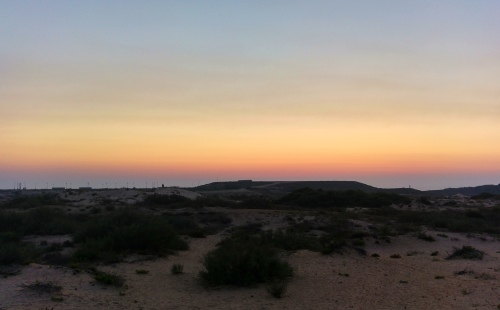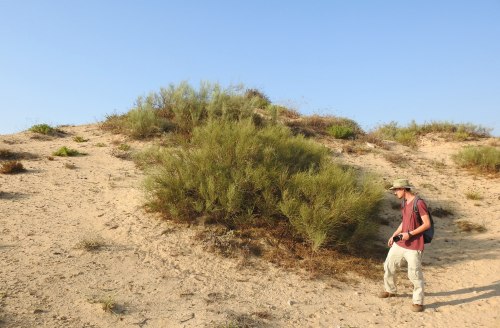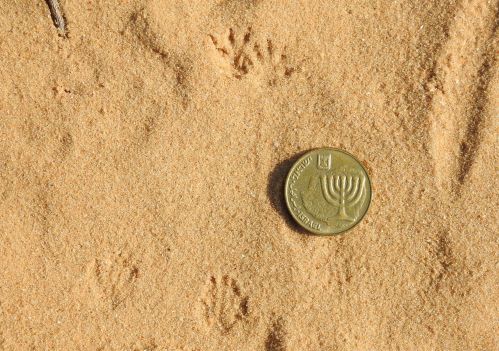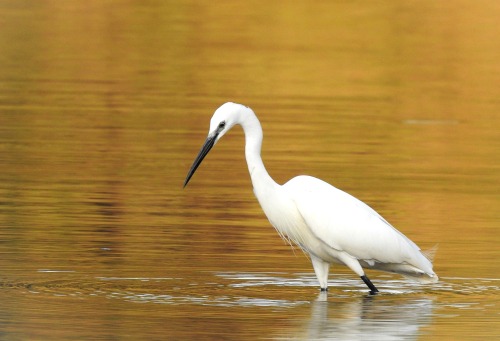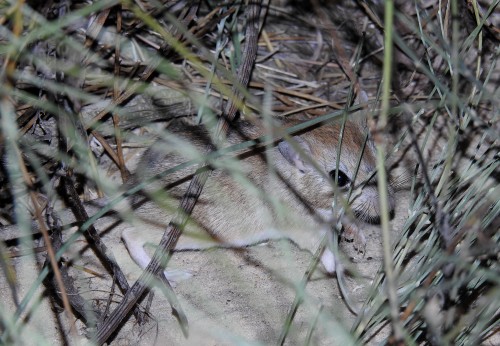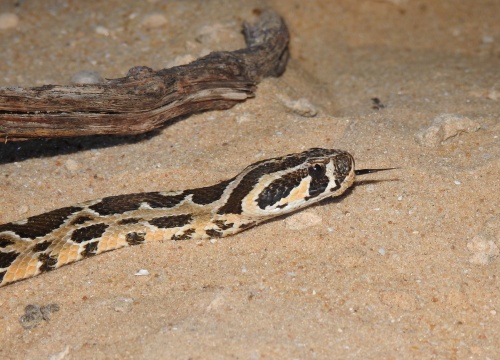The long hot months of summer are usually relatively uneventful in terms of bloggable content, yet exceedingly busy in other aspects of life. Thankfully, birding is particularly dry in Israel during the summer, and there is then less distractions to get in the way of the necessities. However, when the sun sets there is a whole new kind of distraction, found just a bus or two away, and that is the lure of the dune.
Last year was the first time I had explored coastal sand dunes at night, and a series of adventures were enjoyed by myself and my trip companion Adam. We had explored the majority of the Holon Dunes, and had seen a great number of fascinating wildlife species, but there is always more. This summer, just as the bird sightings tapered off, we decided to give a new dune area a try. This was none other than the Rishon LeZion dunes, located between the Superland amusement park and a large military base, which we visited for the very first time on June 10, 2019.
We set out from Givat Shmuel in the afternoon, hoping to scope out the area before darkness fell. Our goal was to map out an area that would be prime for finding interesting creatures of the night, with our ultimate goal being serpents. Despite finding plenty of tracks, we hadn’t seen any snakes in the Holon Dunes, and this failure was scratching at us from deep inside. We needed snakes like we needed water, and armed with our new powerful LED flashlights, we were confident that this summer we’d have results.
Our bus dropped us off at an area that we had believed to be dunes, but is now a vast construction site. Even so, there was some excitement because we nearly immediately found a dead shrew on the pavement near the bus stop. We realised that now we had a bit of a walk to reach any dunes, so we set off and made our way away from the construction. Turning south onto a side road we soon found an area that seemed suitable to our needs. A quick venture into the bush, and we found plenty of signs of wildlife.
Since it was still day there was a good number of birds to be seen, mostly swifts, swallows, stone curlews, bee-eaters and the ever-present mynah. But there were plenty of tracks in the loose sand, including those of tortoises and gerbils which we are always glad to see. As we advanced into the dunes we caught sight of another happy sight – three mountain gazelles prancing about. Just as the gazelles caught sight of us and began to run away, a large flock of chukar partridges also escaped our presence. It was loud and chaotic, the happy sounds of nature protecting itself.
We realised that this is where we wanted to explore that night, and calculating the time until nightfall, made a decision to go check out the nearby Lake Nakik. It wasn’t too far away, even on foot, and we enjoyed the walk as it afforded photographic opportunities of bee-eaters, juvenile chukars and other birds. Before long we reached the small lake, and found that it was nearly empty. Just one little egret was wading near the shore, darting his spear-like bill into the shallow waters in attempts to catch minnows.
Sometimes less is more, and having just this one bird to focus on let me take full photographic advantage. With the golden reflection from the setting sun and the dying leaves above, there was a special beauty that just begged to be noticed. We watched the egret catch a few fish and fly away in search for a better spot. With little else to see we turned back and made our way to the dunes once again, passing the attractions of Superland.
I’m very partial to the cascading shades of colour that sunsets paint the skies with, and to couple it with some wind-swept sand dunes just brings me so much joy. We entered the sandy region, walking along some well-worn footpaths and met the gazelles once again. The sun slowly sank over the horizon and we took out our nighttime gear, eager for the real fun to begin.
The first wildlife sighting of the night was a Rivetina sp. praying mantis, which dashed about on the rippled sand as fast as he could. Just as I was finished photographing it, Adam shouted out that there was an owl passing overhead. I looked up as quick as I could and confirmed that an owl – probably either barn or long-eared – was indeed flying over us. It was a shame that I missed the photo opportunity and I looked down at the shameful mantis with a look of sadness.
The next exciting find was a dung beetle, but not an ordinary dung beetle. This particular one was stuck somehow, flailing his arms and legs as he tried to keep moving. When I moved him I saw something absolutely fascinating. A large antlion nymph had captured the dung beetle in its iconic conical pits, and was in the process of feeding on the injured beetle. Already exposed, I took this opportunity to take some nice photographs of the antlion nymph, just as a fly came by to investigate.
Next, Adam exclaimed that a snake had surprised him, and had disappeared into a wide bush. I dashed over to help find the snake, but alas it was gone and we have no way of definitively identifying it. So, we carried on with a fresh energy, hoping to find another snake. Our next find was an African fattail scorpion, venomous and on the prowl for food. We see dozens of these every time we explore the Holon dunes, so we took a few pictures and continued along.
We crested sandy dunes and rummaged in the vegetation filled valleys between then, searching for something interesting. It was the quick sounds in the bush that alerted us, and then the glimpse of something small and brown dashing for cover. We had stumbled upon a huge bunch of Tristram’s jird lairs, underground dens with numerous tunnels. To our satisfaction, several of them felt rather comfortable around us and getting semi-decent photographs wasn’t an insurmountable task.
That basically summed up our trip, as we had to get some buses back to Givat Shmuel. But, we had determination to come back and try again, which we did exactly one month later, on July 10th. This time we knew where to go in advance, and headed straight for the prime dune area, skipping over the empty Nakik Lake.
We arrived at the dunes at golden hour, about an hour before nightfall. We were greeted by frisky crested larks, a white-breasted kingfisher and a male mountain gazelle – likely the same one as last time.
Our explorations once nightfall began led us directly to a bunch of Tristram’s jirds, as well as an elegant gecko. From there is continued to be relatively normal, with just a lot of jirds and a female lobed agriope spider. We had become to give up hope, wondering why we couldn’t find any snakes no matter how hard we looked. I mumbled a prayer, hoping that it’d help in finding just one serpent. At this point any snake would be a blessing.
We were on our way out of the dune area, walking the long way through some trees. There was a constant rodent presence, mostly jirds but a rat or mouse here and there as well. We took as many pictures as we could, hoping to get a cool shot of these fun rodents. Then we both saw a blur of movement and a jird vaulting itself into the air, leaping up in a most ridiculous way. It was a quick blur of greyish-brown fur, but then we saw it – the reason why it leapt.
Just below the low branches of a bush was a medium-sized viper, who had just struck out at the jird. We didn’t know if its deadly fangs made contact with the gymnastic rodent, but we were spellbound. Adam hurriedly told me to take pictures, and I snapped away as fast as I could. The viper was a bit far from us, a good 5-6 metres or so and I had to make sure the flash lit it up properly with the branches in the way.
We crept closer, hoping to get a good look at the viper. The air was alive with the rush of danger and excitement, and we knew that we needed to play it smart. Unfortunately it was a little skittish and slithered off under the bush’s foliage when we got close. Still, we were spellbound and couldn’t help but exclaim over and over how exciting that was. It was still in our thoughts when we crested yet another dune, not far from the access road.
As I was scanning for snake tracks, Adam shouted out that he found another viper! I dashed over, my hiking boots sinking into the soft sand as I ran, and was elated to see a smaller viper just laying beneath a bit of vegetation. This was perfect, we were able to get close – safely! – and get all the pictures we ever wanted. Both vipers had the same colour pattern, which is the most common morph in Israel, but the size difference was quite noticeable in the field. This second viper was a juvenile and was relatively calm as we crowded it with our lights and cameras.
We wanted to stay with it all night, but we knew that we all needed to part ways. We humans had a bus to catch and the viper was probably hoping for some peace and quiet. So we took one last picture and headed off, leaving the precious viper all alone on the dune.
Grabbing a bus to Tel Aviv, we made it back to Givat Shmuel in relatively good time. As I approached my place I caught notice of a microbat making passes under a strong floodlight, nabbing insects that were drawn to the light. It took a few tries but at last I got a semi-decent picture, decent enough to confirm that it was indeed a Kuhl’s pipistrelle – a common bat in Israel. This sealed quite an excellent nighttime adventure, but our next dunes trip was to be back at Holon, this time with Adam’s youngest brother in tow.
